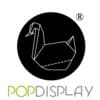Getting your product into a retail store is a battle. But getting it out of the backroom and onto the floor is a war. If your packaging is too complicated, the stock clerk will toss it aside. A "shipper" is your secret weapon to bypass the shelf-stocking chaos.
A shipper in merchandising, often called a Shipper Display, is a pre-packed cardboard unit that serves as both a shipping container and a retail display. It arrives at the store fully stocked, allowing staff to simply cut the top or tear a perforation to place it on the shelf for immediate sale.

The US retail environment thrives on speed. Retailers like Walmart and Target demand packaging that reduces labor costs, making these "ready-to-sell" units essential.
What is a shipper display?
You want your product on the floor in five minutes, not fifty. That's the rule. If it takes a toolbox to open, it's not getting displayed.
A shipper display is a corrugated unit designed to transport products safely and then convert into a point-of-sale fixture. Common types include PDQ trays, pallet skirts, and sidekicks. They eliminate the need for store employees to unpack individual items, ensuring instant planogram compliance.

The Mechanics of the "Cut-and-Stack" System
It sounds simple, right? A box that opens. But here is the messy reality of the factory floor. A major client came to me last year with a design for a "tear-away" shipper. They wanted a clean edge. But when we ran the drop test, the perforations popped open in the truck. The merchandise spilled everywhere. It was a disaster.
We had to re-engineer the entire perforation pattern using a "nicking" technique—leaving tiny 1mm bridges of paper to hold the structure together during the vibrations of a 2,000-mile truck ride, but weak enough for a human hand to rip open cleanly.
For a shipper display to work in the US supply chain, we have to balance two opposing forces: Transport Durability1 and Retail Fragility2.
- Transport: We use 32 ECT (Edge Crush Test) or 44 ECT B-Flute corrugated board. It needs to survive the "vibration test" which simulates a truck hitting potholes. If we use cheap recycled "Testliner" paper, the humidity in a Florida warehouse will turn the box into mush. I learned this the hard way—shippers arriving with "Soggy Bottoms" because the floor moisture wicked up the cardboard. Now, we apply a water-resistant coating to the bottom 2 inches.
- Retail: Once it hits the store, it needs to be "Shop-Through." This means using "Windowed Supports" so customers can see the product from the side. If the walls are too solid, you create dead zones where light can't reach the product.
Also, retailers like Costco have zero patience for "air." We calculate the carton size to fit perfectly into a 40HQ container or a standard 48×40 US pallet. If your shipper overhangs the pallet by even 1 inch, the distribution center robots will reject it.
| Feature | Standard Shipping Carton3 | Retail Shipper Display4 |
|---|---|---|
| Primary Function | Protection Only | Protection + Sales |
| Material Grade | Standard Kraft (Often Recycled) | High-Grade Virgin Kraft (Printable) |
| Opening Mechanism | Tape & Knife required | Perforation / Tear-Tape / Pop-off Top |
| Graphics | Plain Brown / Barcode | High-Fidelity Litho / Branding |
| Store Labor | High (Unpack & Stack) | Low (Drop & Shop) |
I handle the co-packing in my factory, so when the pallet hits the US, it is instantly shoppable.
What is a shipper in marketing?
It's not just a box. It's a billboard that pays for its own rent. If you rely on the standard metal shelf, you are invisible.
In marketing, a shipper acts as a "Silent Salesman" that disrupts the visual monotony of the aisle. It utilizes high-impact graphics and strategic placement (like end-caps or checkout lanes) to drive impulse purchases, increasing sell-through rates by up to 400% compared to standard shelf placement.
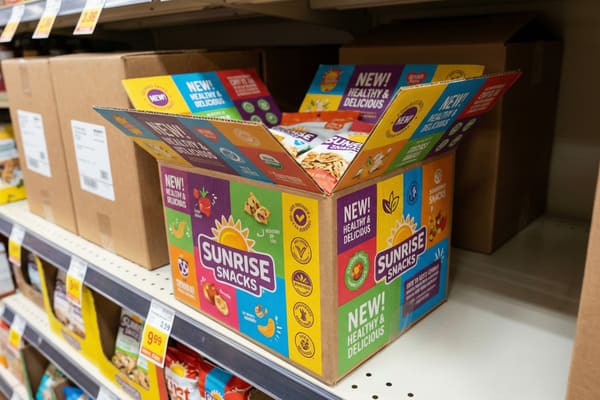
Visual Disruption5 and the 3-Second Rule
Shoppers are tired. They have "Decision Fatigue." When they walk down an aisle, their eyes gloss over the clutter. A shipper display works because of Visual Disruption. Curvy, die-cut shapes—which cardboard does better than metal—grab attention fast.
But here is where marketing dreams die in production: Color Management6.
A marketing manager from New York once sent me a design with a vibrant "Neon Blue." It looked amazing on his backlit MacBook (RGB color mode). But printing uses ink on paper (CMYK). When we printed it, the blue looked muddy and dead. He was furious. I had to explain that you cannot print light.
To fix this, we now use GMG Color Proofing systems. I don't just email a PDF; I send a physical proof on the actual paper stock. If you want a luxury look, I refuse to use standard matte lamination because it scratches instantly when customers touch it. I upgrade to "Anti-Scuff" Matte. It costs pennies more but keeps the brand looking premium for weeks.
Another huge factor is the "Silent Salesman" effect via QR codes. Don't just slap a tiny code on the side. We integrate the QR code into the structural design—make it huge, make it a target. This bridges the physical box to your digital content.
| Marketing Metric | Standard Shelf | Branded Shipper Display |
|---|---|---|
| Visibility | Low (Lost in clutter) | High (Visual Disruption) |
| Brand Real Estate | 2-inch Shelf Strip | 360-degree Header & Base |
| Customer Interaction7 | Passive | Active (Touch & Feel) |
| Sales Velocity8 | Baseline | +400% (Impulse Lift) |
| Launch Speed | Slow (Planogram reset) | Fast (Drop anywhere) |
Don't trust your screen colors; I send physical proofs to guarantee your brand red is actually red.
What is display merchandise?
A display without product is just expensive cardboard. But putting the wrong product inside will kill the display's stability and sales.
Display merchandise refers to the specific inventory curated for the shipper, typically high-velocity or seasonal items. Successful display merchandise is often small, grab-and-go products positioned at the "Strike Zone" (50-54 inches high) to maximize shopper accessibility and impulse buy potential.
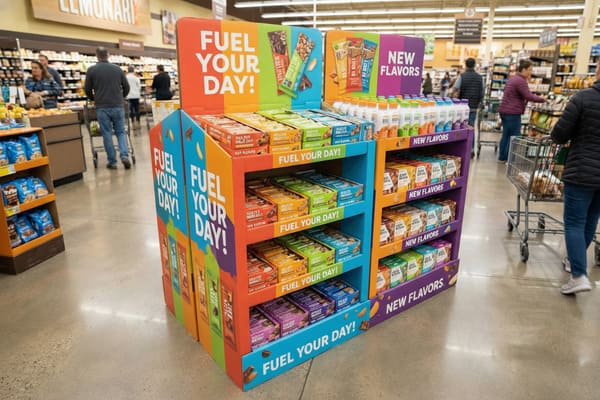
Curating Inventory for the "Strike Zone"
We need to talk about physics. A client tried to fill a dump bin with heavy dog toys—50 lbs of product. Within three days, the internal pressure pushed the cardboard walls outward. The square bin turned into a circle. It looked "pregnant" and unprofessional.
We had to rush in an emergency fix: an internal "H-Divider" or "Belly Band" that acts like a skeleton to tie the front wall to the back wall.
This taught me that Merchandise Weight dictates Structure9.
When planning your display merchandise, consider the "Human Height Heat Map10."
- The Strike Zone (50-54 inches): This is eye level for the average 5'4" shopper. Put your high-margin "Hero Product" here.
- The Stoop Zone (Bottom Shelf): No one wants to crouch. We angle the bottom two shelves upwards by 15 degrees—the "Chin-Up" angle—so the product label looks up at the customer.
Also, be careful with "Gravity Feed" merchandise (cans or bottles). It's not a guessing game. If the angle is too shallow (under 12 degrees), the cans get stuck. If it's too steep (over 18 degrees), they smash into the front lip. We test the "Coefficient of Friction" with your actual product before we cut the die.
| Zone Height | Merchandise Strategy | Structural Need |
|---|---|---|
| Top (Header) | Branding / Message | Double-Wall Fold (No Curling) |
| Eye Level (50-54") | High Margin / New Items11 | Clear Visibility / Lighting |
| Waist Level | Core Volume Sellers12 | Easy Reach Access |
| Knee Level | Bulk / Refill Items | Reinforced "Chin-Up" Shelf |
Gravity is real, so I test your actual product weight to ensure the shelves won't bow.
What is a product display job?
Who actually builds these things? Usually, a busy teenager or an overworked stock clerk who hates reading instructions.
A product display job involves the physical assembly and stocking of merchandising units in a retail environment. Because store labor is expensive and scarce, retailers like Walmart prefer "Shop-Through" pre-assembled displays or units with intuitive, tool-free assembly to minimize labor hours.
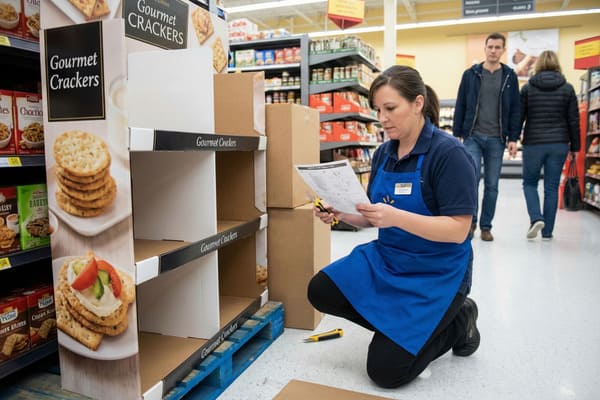
The "Zero-Frustration" Labor Standard
In the US, labor is the highest cost for retailers. If your pallet display takes 20 minutes to build, the store manager will leave it in the back. I've seen thousands of dollars of displays thrown in the compactor simply because they were "too hard" to assemble.
To fix this, we adhere to the "Instruction Manual Reality Check13." Nobody reads the text. Especially if English isn't their first language.
- No Text: We use IKEA-style visual guides.
- QR Video14: We print a giant QR code on the outside of the master carton. The stock boy scans it, watches a 30-second video, and builds it in 2 minutes.
- The Red Bag: Small plastic clips get lost immediately. We tape a "Red Emergency Bag" with 5% spare hardware right to the front sheet.
Safety is also a "job" requirement. Freshly cut corrugated board is sharp—like a razor. I use "Wave Cut" or "Safety Edge" blades on our die-cutters for any hand-access areas. It costs me more in tooling, but it prevents paper cuts. If a store employee gets cut assembling your display, they will hate your brand forever.
| Assembly Factor | Traditional Display | "Labor-Friendly" Display |
|---|---|---|
| Assembly Time15 | 15-20 Minutes | < 5 Minutes |
| Tools Required | Tape, Knife, Screwdriver | Tool-Free (Interlocking)16 |
| Instructions | Dense Text Page | QR Video + Visuals |
| Spare Parts | None | "Red Bag" included |
| Store Compliance | Low (Often trashed) | High (Speed to Floor) |
I keep it simple with video instructions on the box so your display actually gets built.
What is display packaging?
It has to survive a trip across the ocean, a truck ride across the Rockies, and a drop from a forklift.
Display packaging is the specialized engineering of corrugated board to balance shipping durability with retail aesthetics. It utilizes materials like E-Flute for high-quality printing and reinforced Kraft linerboard to pass ISTA 3A transit tests while remaining attractive to the consumer.
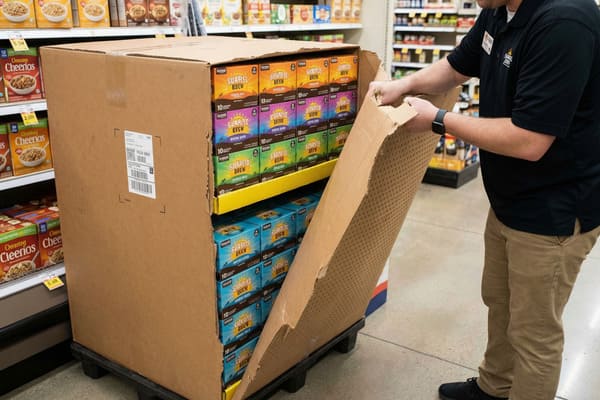
Material Science: The Hidden Strength
Clients always try to cut costs on the paper grade. "Harvey, can we use the cheaper recycled liner?"
I tell them: No.
Recycled "Testliner" has short fibers. When you fold it, it cracks. It looks cheap. More importantly, it has low tensile strength.
For display packaging, I specify High-Grade Virgin Kraft Liner17. The long fibers provide moisture resistance and prevent that ugly cracking at the fold lines.
We also have to fight the "Washboard Effect." Standard B-Flute cardboard has waves. When you print a face or a logo on it, the waves show through. It looks like a bad photocopy.
For premium brands, I switch to E-Flute or a "Litho-Lam on SBS" method. The flutes are so tight they are invisible, giving you a surface as smooth as a magazine cover.
Then there is the "Drop Test18" (ISTA 3A Standards).
Generic "careful packaging" means nothing. We design "Air-Cell" corner buffers—folded cardboard cushions built into the master carton. This creates a 1-inch crumple zone. I can show you video footage of us dropping your display from 1 meter high. The outer box gets crushed, but the display inside is perfect.
| Material Spec | Standard Box | Display Packaging Grade |
|---|---|---|
| Liner Type | Recycled Testliner | Virgin Kraft Liner |
| Flute Type | C-Flute (Thick, Wavy) | E-Flute / B-Flute (Smooth) |
| Printing Surface | Rough | Coated / Varnished |
| Burst Strength19 | Standard | High Tensile (Anti-Crack) |
| Impact Protection20 | None | Air-Cell Corner Buffers |
Quality paper costs 5% more, but it stops your brand from looking tired and cracked in the store.
What is the definition of display packaging?
Let's get technical. Definitions matter when you are dealing with US Customs and sustainability laws.
The definition of display packaging is "secondary packaging designed to contain, protect, and identify products at the point of sale." In the US market, this category must strictly adhere to sustainability protocols, such as using 100% recyclable OCC (Old Corrugated Containers) and water-based inks.
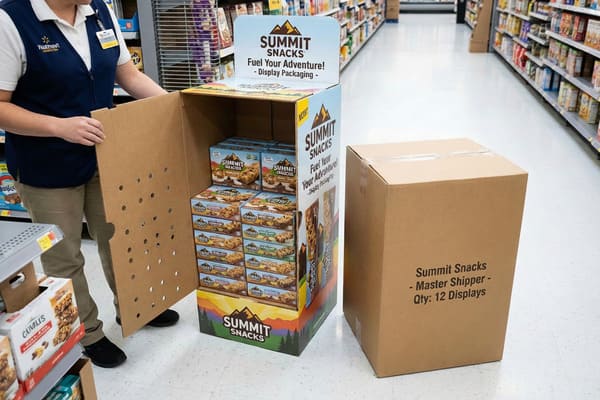
Classification, Compliance, and the "Green" Reality
Classifying your product correctly saves money. Since the Trade War, if you misclassify a display under the wrong HS Code21 (Harmonized System), you could get hit with a 25% tariff. I help clients distinguish between "Printed Matter" and "Packaging Containers" to legally minimize duty exposure.
But the biggest shift in 2025 is the "PFAS-Free" Mandate.
Many US states like California and New York are banning PFAS (forever chemicals) in packaging. Old-school water-resistant coatings were full of this stuff. We now use verified PFAS-Free water-based coatings.
Also, beware of the "Mixed Material" Trap.
I had a client who insisted on "Hot Stamp" gold foil. It looked great, but the plastic film made the cardboard non-recyclable. Whole Foods would have rejected it. I switched them to "Cold Foil." It gives 90% of the shine but is 100% repulpable. This allows you to print the "Curbside Recyclable" logo on the box honestly.
| Feature | Old Standard | US Market Compliant (2025) |
|---|---|---|
| Coating | PE Lamination (Plastic) | Water-Based Varnish |
| Water Resistance | PFAS Chemicals | PFAS-Free Bio-Coatings22 |
| Metallic Finish | Hot Stamp (Non-Recyclable) | Cold Foil / Soy Ink |
| Disposal | Landfill | Curbside Blue Bin (OCC)23 |
I navigate the compliance codes so you don't get hit with fines or tariffs at the border.
Conclusion
Shipper displays are the most efficient way to dominate US retail space. They combine logistics speed with marketing power. But execution is everything—from the glue strength to the grain direction.
Would you like to see how your product fits? I can create a Free Structural 3D Rendering or send you a Physical White Sample to test with your merchandise before you commit.
Understanding Transport Durability is crucial for ensuring your products survive the shipping process. Explore this link for in-depth insights. ↩
Learn how Retail Fragility impacts customer experience and product visibility, essential for effective retail strategies. ↩
Learn about the cost-effectiveness and protective features of Standard Shipping Cartons for your shipping needs. ↩
Explore this link to understand how Retail Shipper Displays enhance product visibility and sales. ↩
Understanding Visual Disruption can enhance your marketing strategies by effectively capturing consumer attention. ↩
Exploring Color Management will help you avoid costly printing mistakes and ensure vibrant, accurate colors in your designs. ↩
Exploring Customer Interaction can reveal effective ways to engage shoppers and boost sales. ↩
Understanding Sales Velocity can help you optimize your retail strategies for better performance. ↩
Understanding how merchandise weight affects display structure can help you create more effective and professional product displays. ↩
Exploring the human height heat map can enhance your merchandising strategy, ensuring products are placed at optimal viewing heights for customers. ↩
Explore this link to discover innovative strategies that can boost your sales and enhance your product offerings. ↩
This resource will help you understand how to pinpoint your best-selling products for maximum profitability. ↩
Explore this link to understand how simplifying assembly instructions can enhance efficiency and reduce waste in retail. ↩
Discover how QR Videos can streamline assembly and training, making it easier for employees to set up displays quickly. ↩
Understanding assembly time can help you choose products that fit your schedule and needs. ↩
Exploring tool-free assembly options can save you time and effort, making your setup process much easier. ↩
Explore this link to understand why High-Grade Virgin Kraft Liner is essential for durability and quality in packaging. ↩
Learn about the ISTA 3A Drop Test to ensure your packaging meets industry standards for safety and performance. ↩
Understanding Burst Strength is crucial for selecting the right packaging that can withstand pressure and protect contents. ↩
Exploring Impact Protection methods can help you enhance the safety of your products during shipping and handling. ↩
Understanding HS Codes is crucial for avoiding tariffs and ensuring compliance in international trade. ↩
Explore this link to understand the advantages of PFAS-Free Bio-Coatings for a sustainable future. ↩
Learn about Curbside Blue Bin (OCC) recycling to enhance your waste management practices and promote recycling. ↩
